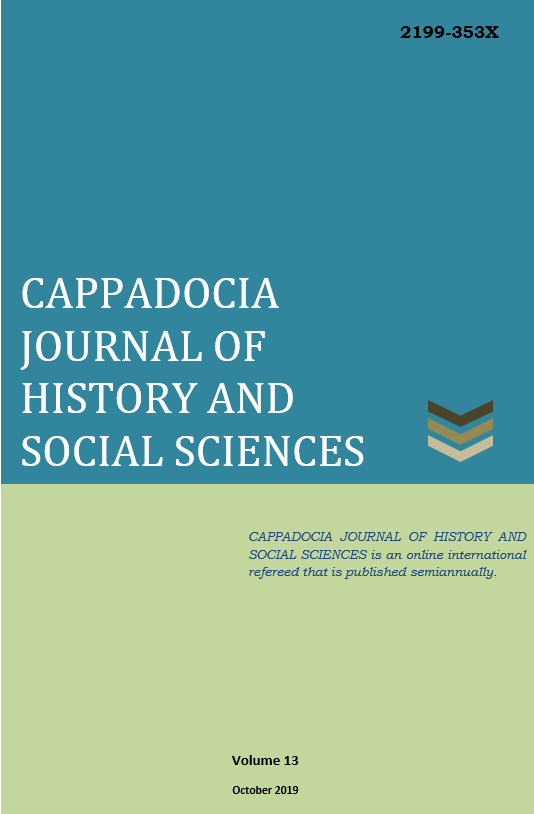Author :
Abstract
Osmanlı Devleti’nin zayıflamasının en önemli sebeplerinden birinin eğitim olduğu görülmüş; bu sahada XIX. yüzyıldan sonra XX. yüzyıl başlarına kadar bir dizi yenilikler gerçekleştirilmiştir. Ancak devletin I. Dünya Savaşı sonunda fiilen sona ermesi ve Milli Mücadele’nin başlamasıyla birlikte eğitim işleri savaş koşulları altında devam etmiş; yurttan düşmanın atılması ve 23 Nisan 1920’de TBMM’nin açılmasıyla Türk toplumunun siyasi, sosyal, hukuki ve ekonomik yapısını değiştirecek inkılap hareketlerine eğitim ve kültür alanları da dâhil olunmuş; böylece Türkiye Cumhuriyeti’ni çağdaş uygarlık seviyesinin üzerine çıkaracak, yeni nesillerin daha millî ve laik bir eğitim almalarını sağlayacak bir sistem ortaya konmuştur. İşte bu çalışmada, 1915-1916 eğitim-öğretim yılında Konya’da açılan Dârü’l-Muallimât/Kız Öğretmen Okulunun ilk mezunlardan Konyalı kadın öğretmenlerinden Saliha Tomris Hanım’ın Milli Mücadele yıllarında Isparta’da başlayan görevinin Cumhuriyet kurulduktan sonra Konya’da devam etmesi incelenecek; Atatürkçü ve inkılapçılığı öne çıkan bir kadın öğretmen olarak onun eğitime katkıları vurgulanacaktır.
Keywords
Abstract
One of the most important reasons for the weakening of the Ottoman Empire was education; From the 19th century to the early 20th century a number of innovations were mad efor this subject. However, with the end of the state at the end of World War I and the start of the National Struggle, the educational activities continued under the conditions of war; with the expulsion of the enemy from the country and the proclamation of Atatürk as the Republic of Turkey on 29 October 1923, educational and cultural fields were included in the revolutions that would change the political, social, legal and economic structure of Turkish society; so will remove the Republic of Turkey on the level of contemporary civilization, it demonstrated a system that allows them to take more national and secular education of the new generations. In this study, Saliha Tomris Hanım, one of the first graduates of Konya female teachers, who started the Dârü'l-Muallimât / Girls Teacher School in Konya in 1915-1916 academic year, started her duty in Isparta during the National Struggle and continued in Konya after the establishment of the Republic. It will be examined; her contributions to education will be emphasized as a woman teacher who is a Kemalist and reformist.
Keywords
- AKDAĞ, Ömer, Tek Partili Dönemde Konya’da 1935 Genel Seçimi, Konya 2018. AKYÜZ, Yahya, Türk Eğitim Tarihi (Başlangıçtan 1985’e), Ankara 1985.
- ÇIPAN, İsmail, Konya Kız Öğretmen Okulu, Selçuk Üniversitesi Sosyal Bilimler Enstitüsü, (Yayınlanmamış Doktora Tezi), Konya 1998.
- DOĞRAMACI, Emel, Türkiye’de Kadın Hakları, Ankara 1982. ERGİN, Osman, Türkiye Maarif Tarihi, II, İstanbul 1977.
- IŞIK, Ali, “Günbay, Saliha Tomris”, IV, Konya Ansiklopedisi, Konya 2012, s. 45. KARAL, Enver Ziya, Osmanlı Tarihi, VI, Ankara 1976.
- KOÇER, Hasan Ali, Türkiye’de Modern Eğitimin Doğuşu ve Gelişmesi (1773-1923), İstanbul 1970.
- KÜÇÜKDAĞ, Yusuf, “Osmanlı Devleti’nin Kuruluşunda Etkin Rol Oynayan Konyalı İlim, Fikir ve DevlatAdamları”, Yeni İpek Yolu Konya Ticaret Odası Dergisi, Konya Kitabı V, Özel Sayı (2002), s. 187-206 Maarif-i Umumiye Nizamnâmesi, İstanbul 1292.
- MUMCU, Ahmet, Tarih Açısından Türk Devriminin Temelleri ve Gelişimi, İstanbul 1984. ÖNDER, Mehmet, Konya Maarifi Tarihi, Konya 1952.
- SUNAR, Mahmut, “Her Yönüyle Konya”, Yeni Konya, 29 Temmuz 1975, s. 3.
- ŞANAL, Mustafa, Türkiye’de Öğretmen Okullarında Okutulan Meslek Dersi Kitaplarının Pedagojik AçıdanDeğerlendirilmesi (1848–1918), Ankara Üniversitesi Eğitim Bilimleri Enstitüsü, (Yayınlanmamış Doktora Tezi), Ankara 2002.
- YÜCEKÖK, Ahmet N, Siyaset Sosyoloji Açısından Türkiye’de Parlamentonun Evrimi, Ankara 1983. YÜCEL, Hasan Ali, Türkiye’de Orta Öğretim, Ankara 1994.
- Selçuk, 9 Şubat 1946; 17 Nisan 1946; 11 Mayıs 1946; 10 Temmuz 1946; 23 Kasım 1946. 21 Şubat 1947; 1 Nisan 1947; 11 Nisan 1947; 5 Eylül 1947; 10 Eylül 1948.
- Yeni Konya, 16 Nisan 1954; 4 Ağustos 1971; 3 Ağustos 1972; 2 Ağustos 1973; 24-30 Temmuz 1975; 27 Haziran 1949





